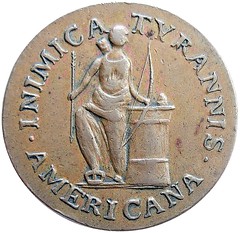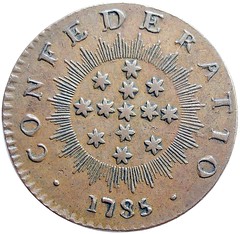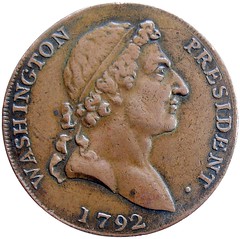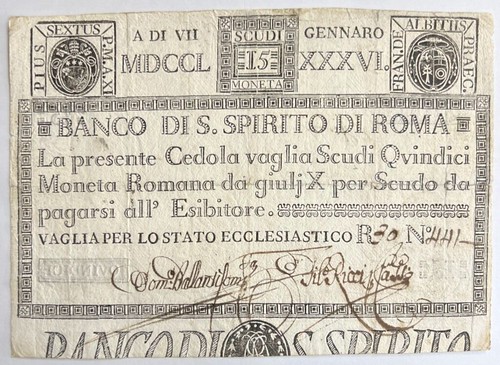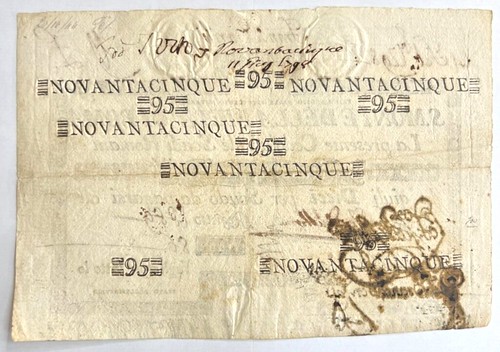
PREV ARTICLE
NEXT ARTICLE
FULL ISSUE
PREV FULL ISSUE
WAYNE'S NUMISMATIC DIARY MARCH 31, 2024Here's an addendum to last week's numismatic diary. First, here's more information on a couple interesting colonial pieces passed around the table at the March 2024 Nummis Nova meeting. Both were recent purchases from Jeff Rock's latest fixed price list. -Editor In his introduction to the list, Jeff writes:
For this price list (#26) I decided to focus on rarities. Everything on this price list is Rarity-6 to Rarity-9 in nature – yes, with some unique things included! – with the exception of state coinages (other than Connecticut coppers) and Fugios, where the threshold was set at Rarity-5, simply because there are so few R-6+ varieties in those series that are currently available – or affordable… This focus solely on rarity means that there are more of certain types than usual, because that is where rarity and affordability intersect, especially St. Patrick's and Hibernia coppers, the French Colonies issues, and Connecticut coppers – though there is a wide offering of other series as well. While it is unlikely that a $100,000 New Jersey copper will double in value anytime soon, it only takes a couple new collectors to make a $500 Hibernia into a four-figure coin. Agreed. Here are Jeff's descriptions. While a number of items sold quickly, I understand others remain available. For a copy of the list, write to Jeff at Rosaamltd@gmail.com . -Editor
ROSA AMERICANA, LTD., FIXED PRICE LIST #26
A PRICE LIST DEVOTED TO AFFORDABLE RARITIES,
53. Choice Extremely Fine. Obv. Diana at altar, INIMICA TYRANNIS AMERICANA around. Rev. Thirteen stars within circle of rays. CONFEDERATIO 1785 around. Smooth light brown surfaces, in fact largely the appearance of a high-grade colonial issue more so than a product of the 1860s. Likely among those artificially worn to pass as a genuine rarity, with even Bolen's secret mark carefully removed at the Y. Provenance: From the Q. David Bowers Collection; Charles Litman Collection; Donald M. Miller Collection.
One of just 30-40 examples struck in copper (Bolen's notebook gives the lower figure, while am 1882 work cited the higher number), these dies were defaced before they were sold, so no other perfect die state pieces could be struck. This example was worn down and almost certainly sold as an original at some point in the 19th century – easy enough to do prior to the publication of the Crosby reference which at least had an illustration of an original specimen that collectors could use to compare. But, as the Stack's Bowers cataloguer stated, this has the look and feel of a coin from the 1780s, on a copper planchet with the right look of the era, and the reverse centering of the Confederatio die a bit off, as one would expect for an original. Undoubtedly more than a few collectors were fooled by this piece, and in 1905 Bolen himself stated "although I have never thought or tried to pass one as genuine, I have often regretted having issued them as I have been informed that they have been worn or rubbed and made to look old, then sold as genuine." An Uncirculated example appeared in the November 2021 sale of the Anton collection and brought $3,840 (the description there well worth reading). This far more deceptive, lightly 67. 1792 Washington Roman Head Cent. Musante GW-21, Baker-19, W-1084. Rarity-6 as an original strike, probably of equal rarity as an electrotype. Choice About Uncirculated, an extremely well-made electrotype of this very rare and immensely popular coin, certainly the high water mark for the 1792 pattern issues, with finely engraved dies by the young John Gregory Hancock – though one could imagine that Washington's reluctance to have his image on a circulating coin would have been magnified a thousand-fold when that image was dressed up like a Roman emperor! Very light rub on the highest points, literally the definition of cabinet friction from a century or more of storage by collectors, but a lovely medium chocolate brown, the surfaces hard, but with some light hairlines that can only be seen with a glass. As an electrotype this lacks the normal lettered edge, and a faint seam where the two shells were joined can be seen on the plain edge. One of the legendary rarities of the Washington series, and a type where rarity usually joins condition – these were not made to circulate, though at least a couple did manage to slip into commerce (including a VG piece that sold at a Stack's auction in January 2009 for nearly $30,000!).
They were prized pieces for collectors in England, where they would have been collected alongside the popular Conder token series – though, oddly enough, the variety is not listed in Dalton and Hamer's work on those tokens (and even more oddly, the cover photo for the Quarterman reprint of that work is a Washington Roman Head cent – a piece not in the book itself!). By the 1860s, and likely a bit earlier than that, the type became known to American collectors – and an 1863 auction sold Walter Breen's fanciful claim of this being intended as a satirical piece has been widely disproven. Hancock was just 17 when these were made, and he clearly intended them for what they were. In Miss Banks's journals she notes only 6 were made – the number known today far exceeds that, and it is likely that Hancock or others struck further pieces to satisfy collectors. And here are some interesting (and LARGE!) banknotes brought by Eric Schena. -Editor
Eric writes: "Here are the two Vatican City horseblankets I brought. The one issued by the Banco di Sancto Spirito di Roma is for 15 (quindici) scudi and dated 7 January 1786. These notes were issued in literally hundreds of different denominations from 3 scudi to 3,000 scudi. The second note is from the Santo Monte Della Pietà di Roma for 95 scudi (novantacinque) dated 14 February 1798. This institution also issued these notes in hundreds of different denominations from 3 scudi top 1,500 scudi." 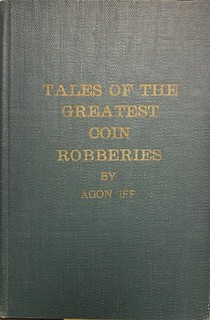
Finally, here's a book I saw offered this week and just couldn't resist adding to my library. The seller said little about its contents, and I'm really looking forward to finding out. I'm not even sure if the subject matter relates to the U.S., Europe, or worldwide. I'm not familiar with the book or its author, and Pete Smith claims it's not his nom de plume. The green cloth binding looks to be from the 1950s or 60s. -Editor
To read the earlier E-Sylum articles, see:
Wayne Homren, Editor The Numismatic Bibliomania Society is a non-profit organization promoting numismatic literature. See our web site at coinbooks.org. To submit items for publication in The E-Sylum, write to the Editor at this address: whomren@gmail.com To subscribe go to: https://my.binhost.com/lists/listinfo/esylum All Rights Reserved. NBS Home Page Contact the NBS webmaster 
|
